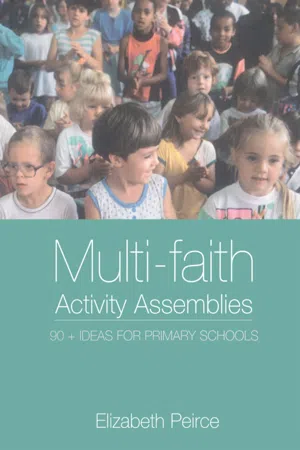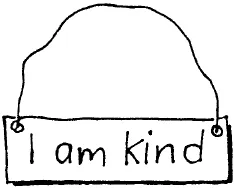1 NEW BEGINNINGS
Who Am I?
5–11
Assembly
All
At the beginning of the new school year or a new term, it is most important to remind the children about the sort of qualities that are needed in any community. With this in mind, think of the various qualities that you would like to encourage in school. Write down some words on large strips of card that can be, threaded with string and then worn around the neck of some children.
With careful preparation, the whole 5–11 age range can be involved in this assembly. The very youngest children can demonstrate, or explain, or paint their phrase e.g. ‘I am helpful’, whereas, an 11-year-old could explain the meaning of ‘I am a Peace-Maker’, either by performing a short mime with one or two of his friends who are quarrelling, or by explaining other examples of peace-making activities.
This assembly has endless possibilities. Phrases such as the following could be included:
I am kind, I am helpful,
I am tolerant, I am polite,
I am caring, I am unselfish,
I have patience, I can let others go before me,
I can be generous, I can let others have the best toy,
I can share, I can tell the truth,
I can comfort those in distress, etc.
At the end of the assembly, the class or group who has prepared the work can say together, ‘I know who I am, who are you?’
Let the children meditate on this penetrating question, by having a time for quiet reflection.
Prayer
Father God, make each one of us the sort of people you want us to be. Kind and helpful, caring and tolerant, ready to put others first. Amen.
Song
No 35, ‘Take care of a friend’ in Every Colour Under the Sun, published by Ward Lock Educational.
Babies
5–7
Assembly
All
Invite a mother and her baby into school. Explain to the children that this assembly is going to be a celebration of new life. Many young children will have had to come to terms with a new baby at home and may need help in coping with feelings of jealousy and rejection. We need to transmit something of the joy, fun and great interest that a new baby can bring.
Preparation for the Mother
If the mother is willing, explain that one of your aims is to make siblings feel loved and wanted, and so ask the mother if she will tell the children this, while chatting about the new baby at home. Perhaps she could bring in some baby clothes, or bath the baby for the children in the assembly and talk about all the equipment that is needed for bathing, dressing, feeding, etc.
Preparation for the Children in School
Perhaps the Year 2 children could prepare a list of questions to ask the mother from the floor:
- What is the baby’s name?
- How old is the baby?
- How much did the baby weigh at birth?
- How much does the baby weigh now?
- How many times a day is the baby fed?
- What do you feed the baby?
- What sort of noise does the baby make when happy? sad? angry?
- What time does the baby go to bed?
- What time does the baby get up?
- How many times a day do you change his nappy?
- What happens when the baby goes to the clinic?
- How many times do you bath the baby a week?
- How do you get the water to the right temperature?
- What sort of games do you play with the baby?
- What sort of toys does the baby have?
Allow sufficient time for questions and answers. Then thank the mother and baby for coming into school. Explain that the children will say a special prayer of thanks for this wonderful new life and for the well-being of mum, and then the children can sing a quiet hymn.
Prayer
Heavenly Father, we do thank you that Mrs . . . [name] was able to visit us today and bring in baby . . . [name]. We have so enjoyed their visit and have learned so much about new babies. We know that you love each one of us just as much as you love this new baby. Thank you for the gift of new life and we ask you to bless . . . [name] and all the family. Amen.
Hymn
No 36, ‘we will take care of you’ in Every Colour Under the Sun (Ward Lock Educational); or No 3, ‘Morning has broken’ in Someone’s Singing Lord A. and C. Black.
Poem
Suitable for 5-year-olds:
Sleepy Baby
I am a baby fast asleep.
Eyes closed, head resting on hands.
I open my eyes to take a peep.
Open eyes.
I lift up my head to look around.
Lift head and look around.
I open my mouth – make a yawning sound.
Yawn.
I lift up my arms and stretch up high.
Stretch.
I think I might be going to cry.
Arms down sad face.
Oh no, I won’t, I’ll go back to sleep.
Head resting on hands again.
I’ll close my eyes and not even peep!
Close eyes and be very still.
Delphine Evans
Moving House
Assembly
5–9
All
(Adapted from the story ‘Love is a runner bean’ in D. Moss (1967) Today’s Talks for Today’s Children (Chester House Publications.)
This story could be mimed while it is being told.
Two friends, John and Mary, lived next door to each other in a tall block of flats in a huge city. Soon they were going to move to a new housing estate and each would have a small garden. They were both delighted because they had never had a garden before. Everything had to be packed up and put into big boxes and there was a lot of rubbish that had to be thrown away.
Soon the great day for removal arrived and the children couldn’t contain their excitement. They were looking forward to moving into their new homes and to going to their new school and to making new friends. They were especially looking forward to having a garden of their own. The men loaded all the furniture onto the van and helped the two families move into their new houses on the same estate. The children were not next door to each other this time, but they were only a few doors away from each other.
Although it was a bit strange at first, as soon as the children’s own special things were unpacked, the houses began to feel more like homes and the children’s parents told the children that they could each have a very small patch in their new gardens to grow their very own vegetables or flowers.
After a great deal of thought, the children decided to grow runner beans. They worked very hard in their own gardens, first digging the soil [mime the action], then planting the beans and finally planting firm canes into the ground to support the beans as they grew. Each day the children watered the seeds and kept their garden patch free from weeds and soon the bean plants began to grow and twist around the poles and produce little tiny beans.
As soon as John’s beans were as big as his little finger, he picked them and gave them to his Mum to cook for the family’s Sunday lunch. It was a very special occasion and there were just enough beans to give each person in John’s family a tiny portion to taste. They were delicious.
Mary, on the other hand, decided not to pick her beans or to share them with anyone. She told her Mum that she wanted to let them grow until they were the biggest and fattest in the whole neighbourhood and then eat them all by herself as she had grown them.
In the meantime a very strange thing happened. Every time John picked his small green beans, more and more appeared. So he gave some to his new neighbours and to an old lady who lived on her own down the street, and he took some to his new teacher and to the lollipop lady at school and still more beans grew and grew. Mary’s beans, however, continued to grow very long and fat. No new beans appeared on her plants. The original beans just grew longer and fatter. Indeed, they were the biggest beans in the whole neighbourhood.
The great day came when Mary decided to pick her beans and have them for Sunday lunch. But they were so tough and stringy that no one in her family could eat them. So they were left politely on the side of the plate. Mary burst into tears. Why were her beans so tough and inedible, when she knew that lots of people had greatly enjoyed eating John’s beans?
Her mother explained. The more you pick runner beans, the more you get. They just keep on growing. But if you leave them, they grow very long and tough. She told Mary that this was a bit like being friendly. The more you give friendship to others, the more you get back. John lovingly gave all his beans away to feed his new neighbours and his plants produced many beans. But Mary kept all her beans to herself and as a result the beans became old and tough and stringy.
John made lots of new friends and settled very quickly and happily into his new home and school. But Mary felt lonely and unhappy and wanted to return to the big city.
A time for quiet reflection is kept.
Hymn
No 42, ‘Seeds of kindness’, in Every Colour under the Sun (Ward Lock Educational); or No 51, ‘I’ve just moved into a new house’, in Tinder-box 66 Songs for Children A. and C. Black.
First Day at School
5–9
Assembly
All
Ask the older children to write about all that they remember of their first day at school. Allow the children to read their work to the rest of the school. The teacher could comment as necessary. The work could be accompanied by children’s paintings depicting some of the most important aspects of school life – their new friends, their new teachers, what they do at school, etc.
These children should then be encouraged to help all the new children to settle in as quickly and as happily as possible. Perhaps the older children could each befriend a new child and help him/her throughout the week, especially at play times and at dinner times and show him/her the daily routine.
This could be followed by the older children dramatizing an incident about including and rejecting friends in movement and mime. To do this, a group of children should mime playing happily together – ‘Ring a Ring o’ Roses’, or ‘In and out the Dusky Bluebells’. One child is left out – an outsider, a new child. She makes several attempts to join the group, to link hands with the other children. As she does this, every child in the group stops playing and puts both hands up in a threatening and forbidding gesture and simultaneously the group turn their heads away from the outsider. The children freeze in this position for one or two seconds, and then the child tries to join the group once more, only to be rebuffed in a similar way.
Eventually the lonely child turns away from the group and goes and sits on her own with her head in her hands and quietly weeps. At this point the teacher should explain that she does not want anyone in her school to feel as lonely and as lef...

